In our current times, it seems almost impossible to establish a business without an online presence.
The internet has revolutionized how we go about life, commerce included, and it seems there is no going back.
This intrigued me to look into how exactly the e-commerce industry has been doing, especially considering that it’s set to overtake the traditional forms of trading. Upon doing some research, I was able to compile a list of e-commerce trends and statistics worth taking into account for any individual trying to understand the current state of global e-commerce.
Global E-Commerce Sales
eCommerce knocked traditional sales right out of the park with its staggering sales figure of approximately 6.31 trillion dollars, which is only expected to grow in the coming years. Experts suggest that by 2026, the growth forecast will be at 24%, meaning this percentage of sales is expected to be online, bringing in about $8.148 trillion.
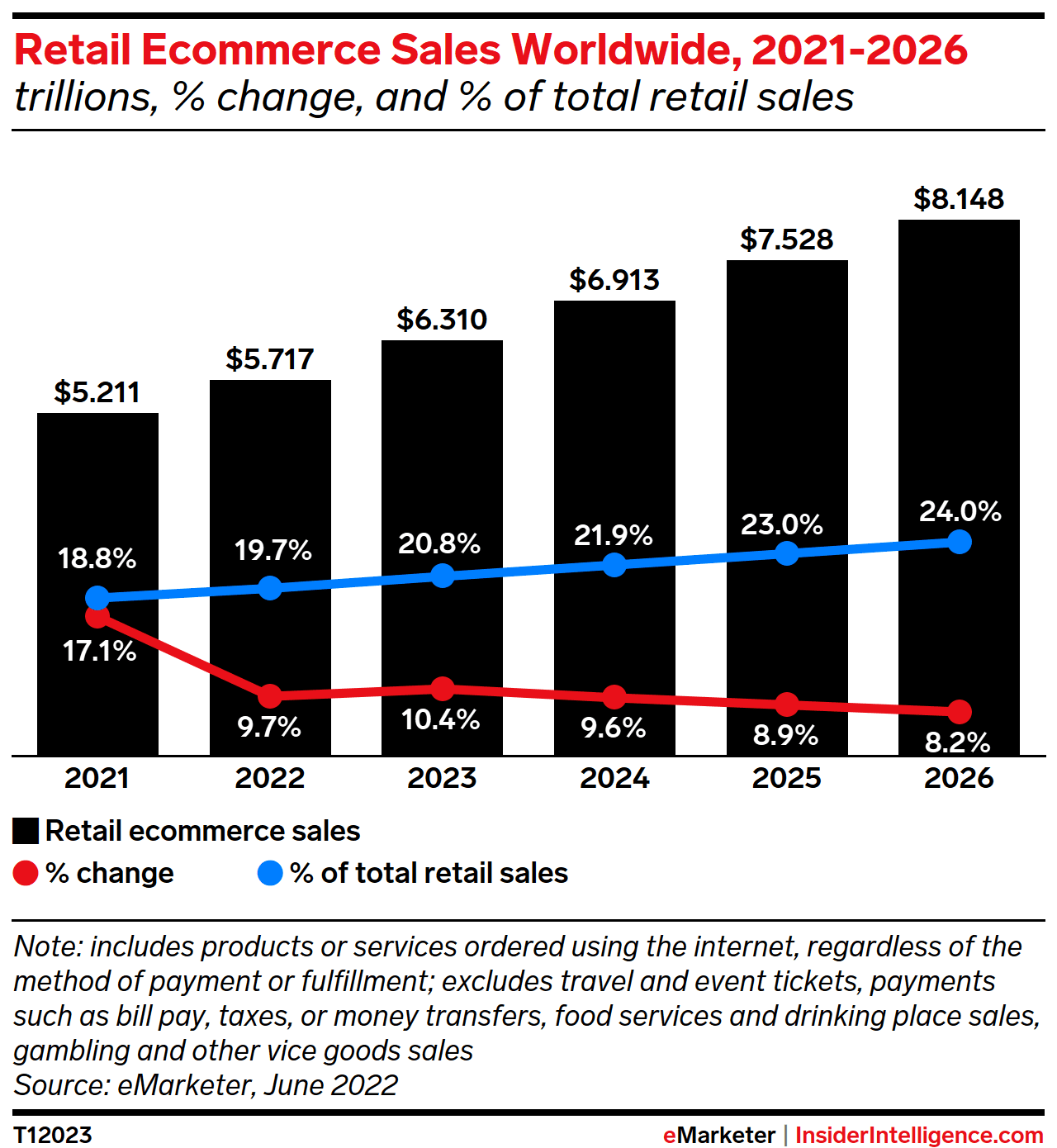
E-commerce sales seem to be fruitful in all parts of the world, but it seems the United States has put the pedal to the metal and attained the fastest-growing e-commerce industry platforms and expects a 50% growth, going from $907.9 billion in 2022 to $1.4 trillion in 2025.
China, which has the largest e-commerce market on the planet, is expected to grow by 15% during this very same period, trailing the U.S. for the second spot in terms of growth.
It is no longer a choice to have a business online but rather a necessity. Considering the trajectory of e-commerce and the likelihood of our dependency on the internet only increasing, businesses will significantly benefit from turning into an online venture and serve as a major stepping stone to scaling up.
Also read: The Complete Guide to eCommerce
It doesn’t surprise me that Amazon rules the e-commerce market yet again. After all, it has become almost an instinct to look for whatever one wishes to purchase on Amazon before anywhere else.
Accounting for 37.8% of all e-commerce sales in the U.S., CEO Andy Jassy has done a remarkable job at keeping business flourishing after the founder and former CEO, Jeff Bezos, stepped down as the CEO in 2021.
Amazon seems to be most profitable in its home ground of the USA, fetching over 356 billion U.S. dollars in sales in 2022.
The second and third spot goes to Walmart and Apple, respectively, with their 6.3% and 3.9% market share in the e-commerce sector. However, Walmart does stand at the top of the hill regarding most traffic gathered, though as of December 2022, it boasted an insane 854.9 million monthly visits.

Mobile E-Commerce
Mobile e-commerce or m-commerce is essentially the buying and selling of goods and services via handheld devices like smartphones and tablets.
In today’s day and age, most individuals have access to a mobile and the internet, considering both have become widely available and affordable after all. So, it comes as no shocker that in 2023, 60% of all e-commerce sales in the world are done using a mobile and have reached an astonishing $2.2 trillion.
Considering most consumers are people (of course) and people are spending more and more time on their mobile devices, the market share of m-commerce is only expected to rise in the coming years. After all those last-second purchases and shopping while in bed, the convenience factor of it all is too good to resist.
It is also worth considering that a major driving force for e-commerce is millennials and Gen Z, both of which are yet to reach their peak earning potential, and both categories predominantly choose to shop online from one platform rather than visit a store.
By the year 2027, it is estimated that m-commerce sales will be up to $2.4 trillion with a 62% market share.

Growing up in the ’90s, it was rare to see consumers fill up their shopping carts, drag them around the mall, and abandon them later, left for dead. However, with the no-pushing-required and everything-is-a-touch-away luxury that online shopping offers, it was observed that the abandonment rate of carts was 79.54% in 2022, an increase from the previous year’s rate of 80.68%.
However, this poses an interesting question: why do we abandon these carts?
It is frustrating for a business owner to get their potential customers through the sales funnel only to abandon sales at the end of the path. Let’s look into why a consumer would do so:
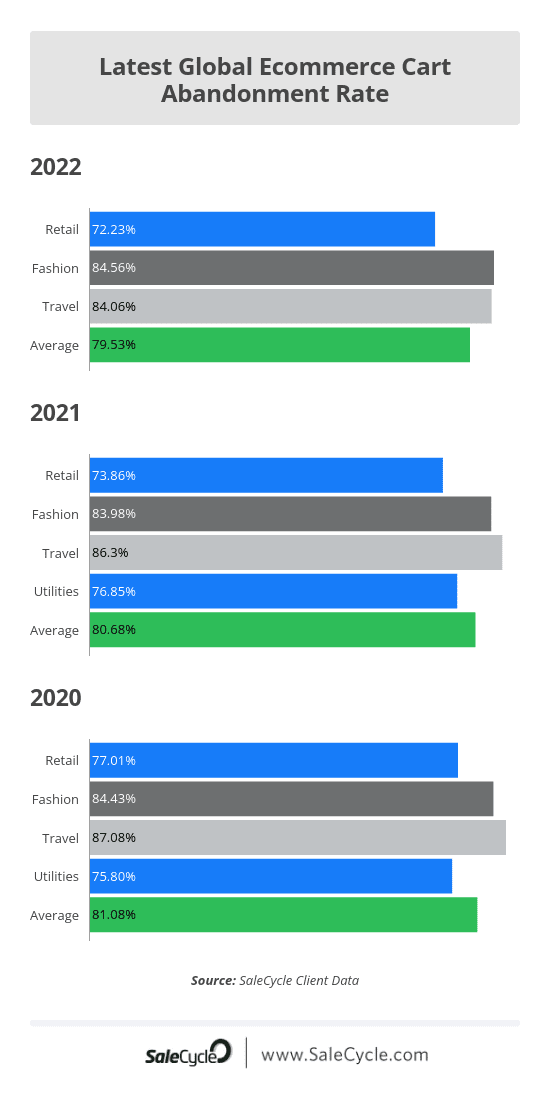
➡️ Unexpected Costs: A 2021 study conducted by the Baymard Institute tells us that approximately 49% of abandoned carts are caused by the high, unexpected final price of the product. A deal that may seem too good to be accurate at first ends up being too good to be true. Sigh!😔
➡️ Lack of Serious Buying Intentions: We’ve all been guilty of adding items to our cart on websites we randomly discovered through an ad. With the ease factor of online shopping, the phenomena of “Window Shopping” has translated into the online sphere in the form of these abandoned carts.
➡️ Creating an Account: Imagine coming across a website with products that pique your interest. You find a lamp you like, hypothetically speaking, and add it to your cart only to be prompted by the dreaded “Create an account.”
Well, unless you’re hellbent on getting that lamp, a casual consumer would simply call it quits there. Understandable on the seller’s end why they would want a consumer to create an account; understandable why a consumer would choose not to.
➡️ Not Enough Payment Options: Having limited payment options is never a good sign in the eyes of a consumer. A lot of consumers would bail if they did not find a preferred payment portal/method or the option to pay at delivery, especially if they were shopping from the website for the first time.
There are ways to reduce the shopping cart abandonment rate, like offering various payment options, easier checkouts, and seeing the product’s actual cost from the get-go and a money-back guarantee.
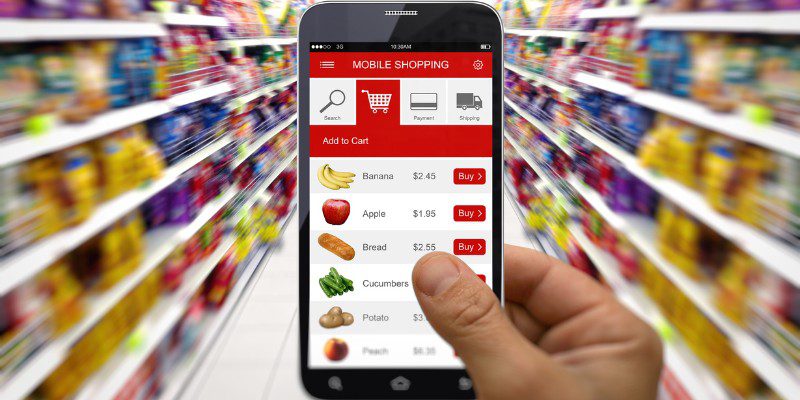
Online grocery shopping saw a meteoric rise during the Covid-19 pandemic. While one could attribute this growth to be caused solely by the pandemic, experts expect online grocery shopping to only increase with time. By 2025, according to Mercatus, 21.5% of all grocery sales will be done online, amounting to about $250 billion of the $1.16 trillion total grocery sales.
In the United States, Walmart is the biggest online grocery retailer, with estimated sales of around $38.7 billion.
Initial buyers may hesitate, but once a consumer goes the route of online grocery shopping, they often become recurring customers, reporting several noticed benefits for traditional grocery shopping, namely, in no particular order:
- Saved time
- No hassle of finding a store nearby
- Safety (considering the pandemic’s after-effects, this is regarded as a major plus)
- Making better choices/avoiding impulse purchases
Not to mention the most obvious element of convenience, of course, as well as the larger variety.

The advent of social media has truly changed the landscape of the world, and it provides the perfect platform to boost the sales of any emerging or established brand. The days of relying solely on flyers and ads on television seem to be things of the distant past.
While still valuable marketing tactics, the new kid on the block, social media influence, holds quite a significant punch.
The hyper-success of brands like Prime Hydration Energy Drink is a perfect example of the influence social media has. Being associated with and founded by 2 mega YouTubers helped its popularity immensely, and its numbers speak for themselves, with $250 million in retail sales within its very first year.
In the holiday season of 2021, it was reported that 58% of consumers’ purchasing decisions were influenced by social media, with platforms like YouTube, Facebook, Instagram, and TikTok being at the forefront of it all.
The preferred platform varies from one generation to another, like Gen-Z preferring Instagram and TikTok over Facebook; the fact remains that most buyers report social media will influence their purchasing decisions. The content that one consumes often reflects in one’s purchasing decisions and willingness to pay.

Voice Commerce
What is the point of technology if it’s not for the ease of mankind? The voice assistant is exactly that: convenience and, well, a necessity in certain cases. You can be doing crunches and ask Alexa, the arguable queen of voice assistants, to make a purchase. In case you have a sight impairment, you can do the same.
Considering those factors, the estimate is that by 2023, the global value of voice assistant e-commerce transactions is expected to reach the $20 billion (U.S.) mark.
There is more than a single voice assistant. Like Alexa, we’ve got Siri. To counter Siri, we’ve got Google Assistant. Both of the latter, in terms of voice assistants on your phone or tablet, outperform Alexa’s mobile voice assistant version. However, Alexa wins the smart speaker war.
Cross-Border E-commerce
Selling products or services to buyers overseas using an e-commerce website is essentially what cross-border e-commerce is. We got that? Sweet.
It is estimated that cross-border e-commerce accounted for 22% of e-commerce shipments of all physical products in 2022.

Though this market is very tempting, thanks “almost” solely to the internet, it does not come without challenges. One must take time to learn the local laws, customs, culture, customs regulations, and standards and have a reliable logistics and delivery setup.
Personalization and Customer Experience
The internet has provided a playground for buyers to personalize the shopping experience for the customer. Orient it towards their liking and what fulfills their requirements.
Studies show that 80% of shoppers prefer to buy from a company that offers them a personalized experience.
One must understand their target market and how to offer the goods and services they are most likely to consume, like offering Metalhead tickets to Gojira, not Ed Sheeran.
Amazon is a fine example of this with their strategy of showing the buyers products they often buy with the one they are currently purchasing. If you buy a guitar🎸, they will offer you a pick.
However, what makes them such a leader in the E-commerce market is their personalization and customer experience. Amazon Prime allows Prime members to complete a survey, providing information like their preferred style and fit.
After analysis by a team of people hired to help you dress better, you’ll get personalized recommendations.

E-commerce Payment Preferences
Despite the apparent belief we may have that human habits don’t change, it seems 49% of all e-commerce transactions were via digital wallet, be it Apple Pay, Google Pay, Paypal, or the rest of the lot.
Despite digital wallets being a relatively new transaction method, they defeated the good ol’ credit card by a single point on the judges’ scorecard!
According to research, 32% of all digital transactions/online payments were made by digital wallets, and 31% were with credit cards, with the bronze medal going to debit cards at 19%.
And a comeback seems to not be in sight as digital wallets are expected to gain a larger share, growing up to 41% of the transactions’ value. Credit and debit cards are expected to fall to 23% and 19%, respectively.
E-commerce Marketplaces
Markets are battlegrounds, be it online or offline. E-commerce marketplaces are plentiful, considering their bounty was an estimated $6.3 trillion in 2023. So, naturally, we have a lot of warriors in the field.
Our top gun is Amazon, with an estimated 4.79B visits a month worldwide, and the 2nd place going to another US-based e-commerce platform, eBay, with approximately 1.21B visits a month in 2022.
Studies show eBay, in the second quarter of 2023, amassed an estimated 132 million active buyers worldwide.
E-commerce and COVID-19
The COVID-19 pandemic had such a massive effect on the overall lifestyle of everyone who lived through it, especially the younger generation; it was bound to cause a ripple effect in the marketplace.
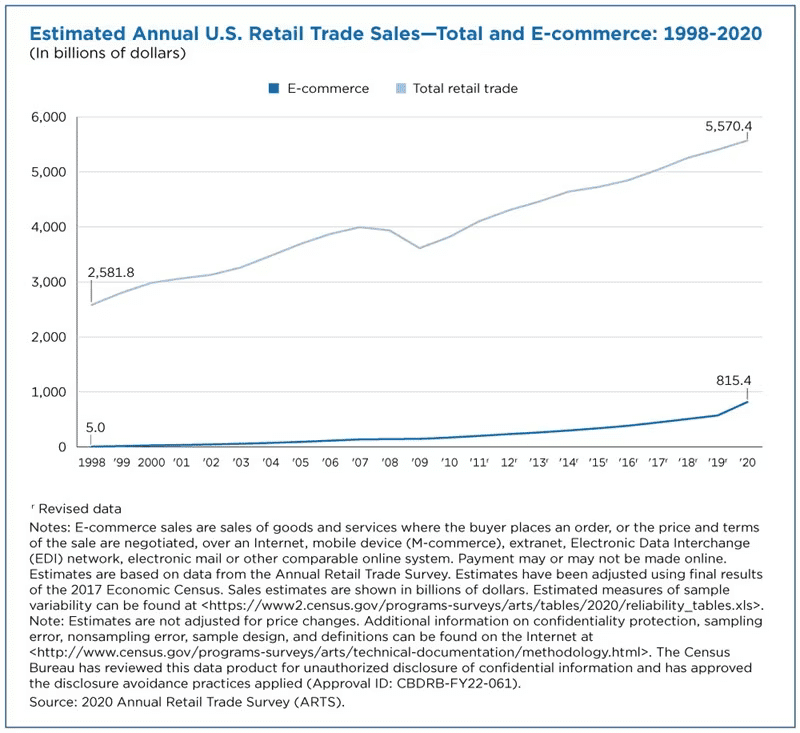
E-commerce was on the rise, but the 2020 pandemic, despite the tragedy it was, jolted the E-commerce market. The United States Census Bureau’s Annual Retail Trade Survey (ARTS) reported data collected in 1998 that online sales were a mere $5.0 billion compared to post-pandemic in 2020, when sales increased to $815.4.
A staggering 43% increase compared to the $571.2 billion in 2019. To complete the math, that is a $244.2 billion markup.
E-commerce User Experience
In a retail store, some obvious things may stand out to you when you think about making the experience better for the buyer, like pleasant management, a store near their location, offering displays, building a nice atmosphere, organizing events to attend, and more. Things aren’t that far for users visiting a website.
A well-designed E-commerce website that offers a beautiful design, engaging content, live chat support, and a clean layout definitely enhances the user experience, but… time is precious. Research shows that a mere 1-second delay in a page’s response time results in a 7% reduction in conversion.
The buyer gets their potential customer through their sales funnel, only for a slow-loading webpage to ruin it. A survey shows that participants were willing to wait about 6-10 seconds before calling it quits.
It is also important to note that the method via which a buyer visits a website makes a difference. On average, mobile users reportedly face slower loading times than desktop/PC users.

Subscription E-commerce
People are creatures of habit, and subscription-based E-commerce caters to our very nature by offering a service or good on a recurring basis for a monthly or annual fee.
It benefits a business owner by bringing in a stable cash flow, making it easier to plan for scaling up strategies and retaining customers. Customers, too, benefit from not having to remember to purchase a good or service they regularly use. They can simply opt for a subscription and have it delivered at the decided time and place.
Despite the pandemic and the current waging war between Russia and Ukraine, it is estimated that the global e-commerce subscription market size is expected to increase from $119.4 billion to 196.3 billion in 2023 at a compound annual growth rate (CAGR) of 64.4%.
By 2027, it is expected to rise to $1482.11 billion with a 65.8% CAGR.
Influencer Marketing in E-commerce
Influencer Marketing is a strategy businesses adopt to bring their service or product into the limelight by collaborating with an organization or individual with a significant social influence. For example, one of the biggest influencers on the planet is Dwyane Johnson, aka The Rock.
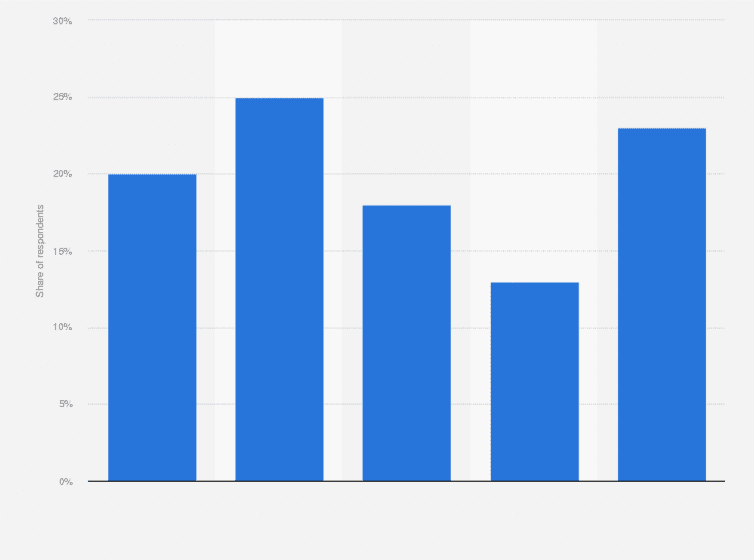
In E-commerce, marketing can often be the key to unlocking global success. A survey conducted globally in 2023 reported that 10-20% of their marketing budget by marketing agencies and brands was invested in influencer marketing.
E-commerce Cybersecurity
As the market share for E-commerce keeps rising, the concerns of cybersecurity and cybercrimes also keep increasing. It is the utmost priority for an E-commerce website to make sure its customers are safeguarded from online frauds and scams, and their data is safe from leaks.
It is estimated that e-commerce losses to online payment fraud are a staggering 41 billion dollars in 2022, which is only expected to rise by 2023, reaching the $48 billion point.
Personal Data Concerns
The more we shop online, the more it seems our data is at risk. A survey shows that 79% of consumers are concerned that their data is at risk of being stolen while shopping online.
It is a major distress for consumers how the data we agree to give a platform is used. What data is being saved, after all? How is it being used? Is it well protected?

Companies are offering much more transparency, answering the above questions to put the minds of their customers at peace. Better security systems are being implemented, and only data relevant to the seller’s products/services and their consumption is being collected.
This collection of data helps sellers gain more insight into their customers’ purchasing habits, offering better products, focused advertisements, and personalized offers.
That is why, despite the concerns and potential risk factors, out of the 10,000 adults surveyed across 10 nations, 64% reported that they are willing to accept the risks since it makes their shopping experience much more convenient.
Closing Thoughts
E-commerce is a major marketplace, and its growth and potential are undeniable. A business that needs to scale up has to invest in an e-commerce platform, utilizing the correct strategies and avoiding the cons by analyzing the statistics and data on offer.
I hope the data and statistics discussed in this post helped you better understand the e-commerce space.
Next, you’d love to check out these mind-boggling Netflix statistics and data.
Si quiere puede hacernos una donación por el trabajo que hacemos, lo apreciaremos mucho.
Direcciones de Billetera:
- BTC: 14xsuQRtT3Abek4zgDWZxJXs9VRdwxyPUS
- USDT: TQmV9FyrcpeaZMro3M1yeEHnNjv7xKZDNe
- BNB: 0x2fdb9034507b6d505d351a6f59d877040d0edb0f
- DOGE: D5SZesmFQGYVkE5trYYLF8hNPBgXgYcmrx
También puede seguirnos en nuestras Redes sociales para mantenerse al tanto de los últimos post de la web:
- Telegram
Disclaimer: En Cryptoshitcompra.com no nos hacemos responsables de ninguna inversión de ningún visitante, nosotros simplemente damos información sobre Tokens, juegos NFT y criptomonedas, no recomendamos inversiones


